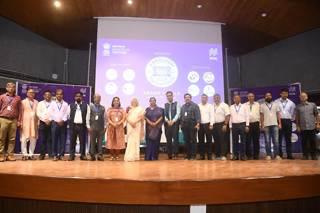 Image Source: PIB
Image Source: PIB
In a pioneering event spotlighting India’s rich handloom heritage and technological innovation, the country's largest handloom-focused hackathon successfully brought together more than 400 young minds at the prestigious Indian Institute of Technology Delhi (IIT Delhi) on August 2-3, 2025. This first-of-its-kind initiative, organized under the aegis of the Development Commissioner for Handlooms, aimed to foster innovation, empower artisans, and catalyze the modernization and sustainability of the handloom sector by bridging traditional craftsmanship with contemporary solutions.
Key Highlights: Collaboration, Innovation, and Empowerment
The hackathon featured over 400 participants comprising students, industry professionals, designers, and technologists converging at IIT Delhi to ideate and develop innovative solutions for challenges faced by the handloom sector.
The event was officially launched by Dr. M Beena, Development Commissioner for Handlooms, who emphasized the significance of engaging youth and leveraging technology to preserve and propel India’s handloom legacy.
Participants engaged in brainstorming, prototyping, and presenting creative concepts addressing areas such as supply chain digitization, sustainable raw material sourcing, design innovation, market access enhancement, artisan welfare, and digital marketing strategies.
The hackathon’s collaborative environment encouraged cross-disciplinary teamwork, combining heritage understanding with expertise in AI, IoT, e-commerce, and fashion technology.
Event Framework and Activities
Spanning two intensive days, the hackathon included expert sessions on handloom history, sectoral pain points, future trends, and technological interventions by industry veterans and policymakers.
Teams tackled real-world problems submitted by handloom clusters and cooperatives, ensuring that solutions were grounded in authentic needs and had practical applicability.
Facilities at IIT Delhi provided state-of-the-art infrastructure, mentorship from faculty and sector experts, and networking opportunities fostering rich dialogue between tradition and innovation.
The culminating presentations showcased diverse innovations including mobile apps for artisan-product traceability, eco-friendly dyeing techniques, augmented reality tools for design visualization, and blockchain-based transparency frameworks.
Strategic Importance and Sectoral Impact
The hackathon aligns with the government’s broader vision under initiatives like the National Handloom Development Programme to revitalize handlooms as a sustainable livelihood option while enhancing global competitiveness.
It encourages young entrepreneurs and technologists to contribute solutions that promote artisan empowerment, reduce migration, sustain cultural heritage, and open new markets domestically and internationally.
By integrating technology with handloom craft, the hackathon aims to increase efficiency, reduce wastage, create value-added products, and attract younger consumer segments keen on heritage yet modern products.
The event supports India's commitments to Sustainable Development Goals related to decent work, economic growth, innovation, and responsible consumption.
Future Prospects and Continuing Engagement
Winning ideas and prototypes from the hackathon will receive incubation support, funding facilitation, and pilot implementation opportunities through government and partner networks to scale impact.
Continuous engagement through workshops, innovation challenges, and online platforms will nurture a vibrant ecosystem connecting artisans with tech innovators and markets.
Plans include extending the hackathon model to other handloom clusters nationwide, fostering regional innovation hubs with customized challenges.
The event also highlighted the importance of awareness campaigns and capacity building to attract youth participation and create sustainable employment in the handloom industry.
Conclusion
India's largest handloom-focused hackathon at IIT Delhi represents a milestone in linking heritage crafts with modern innovation. By harnessing the energy and creativity of over 400 young participants, it sets a transformative agenda to safeguard and elevate the handloom sector for future generations. This initiative exemplifies how tradition and technology can coexist synergistically, creating inclusive growth pathways and ensuring that India's timeless handloom artistry continues to flourish globally.
Sources: Development Commissioner (Handlooms) Instagram
Advertisement
Advertisement




